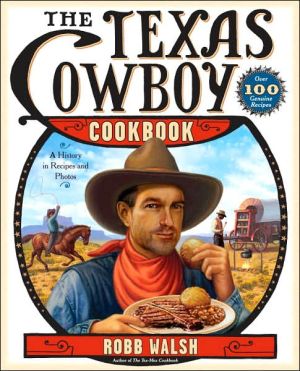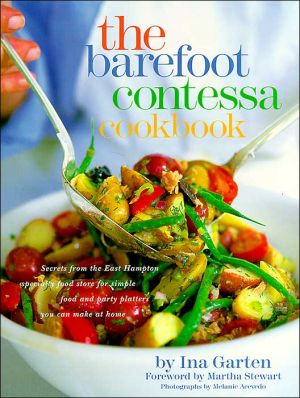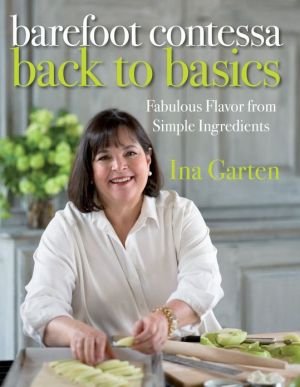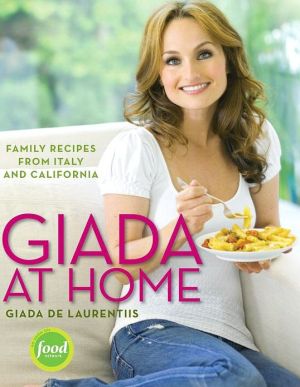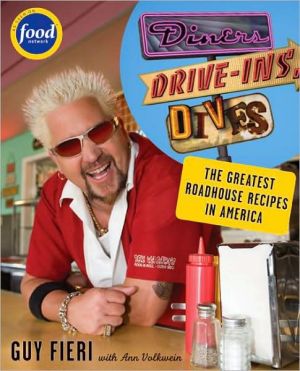Texas Cowboy Cookbook: A History in Recipes and Photos
Texas cowboys are the stuff of legend — immortalized in ruggedly picturesque images from Madison Avenue to Hollywood. Cowboy cooking has the same romanticized mythology, with the same oversimplified reputation (think campfire coffee, cowboy steaks, and ranch dressing). In reality, the food of the Texas cattle raisers came from a wide variety of ethnicities and spans four centuries.\ Robb Walsh digs deep into the culinary culture of the Texas cowpunchers, beginning with the Mexican vaqueros...
Search in google:
Texas cowboys are the stuff of legend — immortalized in ruggedly picturesque images from Madison Avenue to Hollywood. Cowboy cooking has the same romanticized mythology, with the same oversimplified reputation (think campfire coffee, cowboy steaks, and ranch dressing). In reality, the food of the Texas cattle raisers came from a wide variety of ethnicities and spans four centuries.Robb Walsh digs deep into the culinary culture of the Texas cowpunchers, beginning with the Mexican vaqueros and their chile-based cuisine. Walsh gives overdue credit to the largely unsung black cowboys (one in four cowboys was black, and many of those were cooks). Cowgirls also played a role, and there is even a chapter on Urban Cowboys and an interview with the owner of Gilley’s, setting for the John Travolta—Debra Winger film.Here are a mouthwatering variety of recipes that include campfire and chuckwagon favorites as well as the sophisticated creations of the New Cowboy Cuisine:• Meats and poultry: sirloin guisada, cinnamon chicken, coffee-rubbed tenderloin• Stews and one-pot meals: chili, gumbo, fideo con carne• Sides: scalloped potatoes, onion rings, pole beans, field peas• Desserts and breads: peach cobbler, sourdough biscuits, old-fashioned preservesThrough over a hundred evocative photos and a hundred recipes, historical sources, and the words of the cowboys (and cowgirls) themselves, the food lore of the Lone Star cowboy is brought vividly to life. Publishers Weekly A Houston native with two James Beard awards, Walsh (Legends of Texas Barbecue Cookbook) carves Texas up into digestible sections, collecting its juices and leaving lots of contemplative fat. This 10-chapter history reaches as far back as the year 1540, when cattle first came to the area, and examines a multitude of geographic and demographic influences on the Lone Star State's cuisine. It is both a study of rich diversity and a collection of over 100 recipes, though only perhaps a quarter of the meals rise above the commonplace. The liveliest dishes turn up in the section on South Texas and are presented with a Hispanic flair, such as Conejo Colorado (Rabbit Stewed in Red Chile Sauce). There are two intriguing chapters that examine how black slaves transformed into black cowboys and were responsible for the introduction of Texas barbecue, but the accompanying recipes are disappointingly old hat. A fun chapter on Cowgirls in the Kitchen has some of the best of the book's 150 b&w photos as well as a swell Buttermilk-Lemon Pie. Moving into modern times, there is perhaps too much attention paid to the movie Urban Cowboyand the cultural and epicurean importance of Mickey Gilley, but Walsh wraps up his enterprise nicely with entrees such as a Poblano Mac & Cheese and a broiled tenderloin marinated in the black gold of Waco: Dr. Pepper. (Apr.)Copyright 2007 Reed Business Information
Chapter 1\ The Texas Cowboy Myth\ Picture a bunch of cowboys sitting around a campfire eating from tin plates and drinking black coffee from tin cups. Beside them is the iconic horse-drawn kitchen called the chuck wagon, stocked with everything they will need to eat for servearl months. THis is the image of cowboy cooking that became a part of the history of Texas and the Old West.\ Modern scholars have pointed out that much of what we mistake for history is actually part of “the myth of the West,” a jungle of fact and fantasy derived from pulp fiction, Wild West shows, television weterns, and cowboy–and–Indian movies. The reexamination of cowboy history currently taking place in Texas colleges and universitites is giving us some startling new views of cowboy culture.\ Of course, there really were chuck wagons in the Old West. There really were gunfights at high noon and poker games played in saloons with swinging doors, too. It’s just that these well–dramatized clichés were actually only a small part of a much more complex story.\ After the Civil War, Texas was, in fact, a defeated slave state with a sizable minority population and a serious problem with the Comanches. But thanks to dime novels and Wild West shows, the rest of America thought of the Lione Star State as one big Wild West town populated entirely by white, pistol–packing cowboys.\ The image of the Texas cowboy and cowboy cooking that is forever locked in the public imagination comes from the twenty–year heyday of the trail drives, between 1866 and 1886. The cowboys who rode the trail were a tough breed. They included former Confederate soldiers, freed slaves, and Hispanic vaqueros—men without a lot of other prospects at the end of the Civil War. For as little as a dollar a day, they were willing to risk the trip through Indian territory, protecting a herd of cattle.\ Wild cattle that were free for the taking in the South Texas brush country could be sold for thirty or forty dollars a head in Abilene, Kansas, and other railhead towns that served the beef–starved northern markets. In a few decades, millions of longhorns were driven from Texas across the prairies.\ Scenes from this short–lived “cattle–rush” era—including the stampede, the Indian attack, the singing cowboy, and dinner around the chuck wagon—became clichés as they were endlessly repeated in cowboy dime novels, and lter in cowboy movies and comic books.\ Picante sauce\ This is the ubiquitous Tex–Mex table sauce and tortilla chip dip; it also tastes great on eggs, tamales, and nachos. Roasting the vegetables adds depth to the flavor of the sauce. Soaking the onions in the lime juice and salt “cooks” them and removes some of their bitterness. Before the blender was invented, this salsa was made in the three–legged stone grinding bowl called a molcajete.\ Makes 3 cups\ • 1/2 onion, finely diced\ • 1 1/2 tablespoons fresh lime juice\ • 6 plum tomatoes\ • 2 jalapeños, seeded and halved lengthwise\ • 1 garlic clove, peeled\ • 1 cup chopped fresh cilantro\ • salt\ Soak the onion in the lime juice for at least 10 minutes. Roast the tomatoes, jalapeño halves, and garlic clove in a hot skillet until slightly charred. Remove the tomato skins. Puree in the blender for about 10 seconds so the mixture remains chunky. Transfer to a bowl and add the onion and lime juice and the cilantro. Season with salt to taste. The sauce will keep in the refrigerator for up to a week.\ \ Sourdough biscuits\ Sourdough is notoriously stubborn when it comes to rising. Every cook–off contestant we’ve met adds yeast or baking powder or both to speed things up. If you want to be a purist and see what it’s like to use nothing but sourdough for leavening, you will need to allow as much as an entire day of rising time. If the temperature outside is higher than 70°F, put the sourdough outside to rise with a clean kitchen towel over the top of the bowl or loaf pan to keep the flies away.\ \ Makes 12 To 15\ • 3 cups sourdough starter (page 35)\ • 1 tablespoon active dry yeast (optional)\ • 3 tablespoons sugar\ • 3 tablespoons baking powder\ • 2 teaspoons salt\ • 5 tablespoons vegetable oil\ • 3 cups all–purpose flour\ • 1 tablespoon butter, melted\ Lightly grease a Dutch oven or cookie sheet.\ In a large mixing bowl, stir together the sourdough and the dry yeast (if using) and let them sit for 5 minutes. Add the sugar, baking powder, salt, and oil and mix well. Add the flour, 1 cup at a time, and mix until the dough becomes too stiff to stir. Turn the dough out onto a lightly floured surface and sprinkle some flour on top. Roll it out until it is about half–inch thick. Using a circular cookie cutter, a tin can with both ends removed, or a water glass, cut circles from the dough and place them on the bottom of the Dutch oven or cookie sheet. Brush the tops with the melted butter and cover with a clean cotton cloth.\ Set the biscuits aside and let them rise until they double in size.\ Preheat the oven to 325°F.\ Bake until golden brown, about 15 minutes. Allow to cool for a few minutes; serve when they don’t burn your fingers.\ Texas Chili\ In the days of the Chili Queens of San Antonio, chili con carne was a stew cooked in the Mexican clay pot called a casuela. Texas cowboy cooks began preparing this browned and simmered version of chili con carne when the Dutch oven appeared after the Civil War. Spicy canned tomatoes with roasted green chiles added are a modern convenience. Serve with rice or tamales, over tortilla chips, on hamburgers, or eat it out of a bowl with crackers.\ Serves 8\ • 4 pounds chuck, cut into 1/2–inch cubes or ground through a 1/2–inch plate\ • 1 large onion, chopped\ • 2 garlic cloves, minced\ • 1 teaspoon dried Mexican oregano\ • 1 teaspoon ground cumin\ • 2 tablespoons Homemade Chili Powder (page 20)\ • 1 can Rotel tomatoes with chiles (page 81)\ • 2 to 6 generous dashes of Tabasco sauce\ • Salt\ • 2 tablespoons masa harina (optional)\ In a large skillet over medium–high heat, sauté the meat, onion, and garlic until lightly colored. Add the oregano, cumin, chili powder, tomatoes, Tabasco, and 2 cups hot water. Bring to a boil, lower the heat, and simmer for about 1 hour. Skim off the fat while cooking. Salt to taste. If you wish to thicken your chili, add a little warm water to the masa harina in a mug until it forms a lump–free slurry. Add this a little at a time, stirring vigorously, until the chili reaches desired thickness. Serve hot.
\ Publishers WeeklyA Houston native with two James Beard awards, Walsh (Legends of Texas Barbecue Cookbook) carves Texas up into digestible sections, collecting its juices and leaving lots of contemplative fat. This 10-chapter history reaches as far back as the year 1540, when cattle first came to the area, and examines a multitude of geographic and demographic influences on the Lone Star State's cuisine. It is both a study of rich diversity and a collection of over 100 recipes, though only perhaps a quarter of the meals rise above the commonplace. The liveliest dishes turn up in the section on South Texas and are presented with a Hispanic flair, such as Conejo Colorado (Rabbit Stewed in Red Chile Sauce). There are two intriguing chapters that examine how black slaves transformed into black cowboys and were responsible for the introduction of Texas barbecue, but the accompanying recipes are disappointingly old hat. A fun chapter on Cowgirls in the Kitchen has some of the best of the book's 150 b&w photos as well as a swell Buttermilk-Lemon Pie. Moving into modern times, there is perhaps too much attention paid to the movie Urban Cowboyand the cultural and epicurean importance of Mickey Gilley, but Walsh wraps up his enterprise nicely with entrees such as a Poblano Mac & Cheese and a broiled tenderloin marinated in the black gold of Waco: Dr. Pepper. (Apr.)\ Copyright 2007 Reed Business Information\ \ \ \ \ Library JournalWalsh is the author of The Tex-Mex Cookbook, among other titles, and a National Public Radio commentator. For his latest book, he explored the reality behind the enduring "cowboy myth" (i.e., the stuff of movies), which results in a highly readable history of the real Texas cowboys-and cowboy cooking-from the Mexican vaqueros and black cowboys up through the Gilley's era (Urban Cowboy) and chef Robert Del Grande's "new cowboy cuisine." There are 100 recipes, from Sourdough Biscuits and Picadillo to Bull's-Eye BBQ Pork Tenderloin, along with period photographs of chuckwagon cooks, working cowboys, and often desolate Texas landscapes. Walsh's text is thoroughly researched, and oral histories, minibiographies of memorable characters, and sidebars on such topics as "Chicken-Fried Insights" provide further context. Entertaining and informative, this is highly recommended.\ \ —Judith Sutton\ \
